Pest Control
Ants
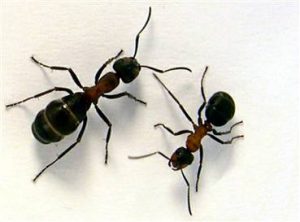 In this section, you will learn how to identify common household ants.
In this section, you will learn how to identify common household ants.
Ants are among the most prevalent pests in households. They are also found in restaurants, hospitals, offices, warehouses, and other buildings where they can find food and water. On outdoor (and sometimes indoor) plants, ants protect and care for honey-dew producing insects such as aphids, soft scales, whiteflies, and mealybugs, increasing damage from these pests. Ants also perform many useful functions in the environment, such as feeding on other pests (e.g., fleas, caterpillars and termites), dead insects, and decomposing tissue from dead animals.
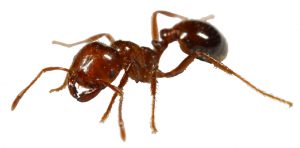 In California, there are about 200 species but fewer than a dozen are important pests. The most common ant occurring in and around the house and garden in California is the Argentine Ant. Other common ant pests include the Pharaoh Ant, the Odorous House Ant, the Thief Ant and the Southern Fire Ant. The Velvety Tree Ant nests in old wood and is a common outdoor species in landscapes. Less common, but of great importance, is the Red Imported Fire Ant, which has recently gained a foothold in southern California. In some areas, the spread of the fire ant has been slowed by competition from the Argentine ant.
In California, there are about 200 species but fewer than a dozen are important pests. The most common ant occurring in and around the house and garden in California is the Argentine Ant. Other common ant pests include the Pharaoh Ant, the Odorous House Ant, the Thief Ant and the Southern Fire Ant. The Velvety Tree Ant nests in old wood and is a common outdoor species in landscapes. Less common, but of great importance, is the Red Imported Fire Ant, which has recently gained a foothold in southern California. In some areas, the spread of the fire ant has been slowed by competition from the Argentine ant.
Carpenter Ants, also invade buildings in California. Although they do not eat wood as termites do, they hollow it out to nest and may cause considerable damage.
Ant Facts
- Ants belong to the insect order Hymenoptera and are close relatives of bees and wasps.
- More than 12,000 species occur throughout the world.
- 200 species occur in California, but fewer than a dozen are important pests.
- Ants are common pests in homes, restaurants, hospitals, and warehouses.
- Ants enter buildings seeking shelter, food, and water.
- Established ant colonies are difficult to control.


Argentine ant
- Food: sweets, sometimes proteins
- Nest: outdoors in shallow mounds.
- Physical description: 1/8 inch, dull brown

Carpenter Ant
- Food: sweets.
- Nest: in tree stumps, firewood, fence posts, hollow doors or window frames; deposits sawdust like frass outside nests.
- Physical description: large, workers vary from 1/4 to 1/2 inch, black or bicolored red and black

Odorous house ant
- Food: sweets, sometimes proteins.
- Nest: in shallow mounds in soil or debris or indoors in wall voids or around water pipes or heaters
- Physical description: 1/8 inch, dark brown to shiny black, very strong odor when crushed

Pavement ant
- Food: sweets, proteins, grease
- Nest: in lawns or under stones or boards; builds mounds along sidewalks and foundations or near water
- Physical description: 3/16 inch, dark brown to black
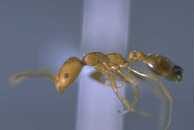
Pharaoh ant
- Food: fats, proteins, sweets
- Nest: in wall or cabinet voids, behind baseboards or insulation, or outdoors in debris
- Physical description: 1/16 inch, yellow or honey-colored to orange
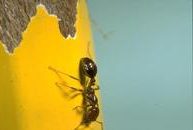
Red imported fire ant
- Food: sweets, proteins.
- Nest: in mounds with multiple openings in soil or lawns and sometimes in buildings behind wall voids
- Physical description: workers vary from 1/16 to 1/5 inch, reddish with dark brown abdomen
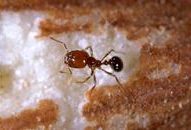
Southern fire ant
- Food: proteins and sweets
- Nest: in small mounds with flattened, irregular craters in wood or under rocks
- Physical description: workers vary from 1/8 to 1/4 inch, amber head and thorax, black abdomen, golden hairs cover body

Thief ant
- Food: greasy and fatty, sometimes sweets. Steals food and ant larvae from other ant nests.
- Nest: outdoors in soil or under rocks or decaying wood, indoors behind wallboards or baseboards
- Physical description: 1/32 inch, yellow to light brown
Bees
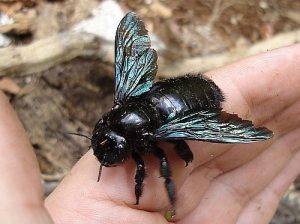 Carpenter bees build nests in wood, creating galleries that can weaken structures; however, they rarely cause severe damage. People may be frightened by carpenter bees because of their large size, their similarity to bumble bees, and their annoying noise.
Carpenter bees build nests in wood, creating galleries that can weaken structures; however, they rarely cause severe damage. People may be frightened by carpenter bees because of their large size, their similarity to bumble bees, and their annoying noise.
Identification
Most carpenter bees, are large and robust insects resembling bumble bees. They are usually about 1 inch long and colored a metallic blue-black with green or purplish reflections. They differ from bumble bees in that there is shiny with fringes of hairs on some segments. Males of some species are lighter colored, ranging into golden or buff hues.
Carpenter bees cause damage to wooden structures by boring into timbers and siding to prepare nests. The nests weaken structural wood and leave unsightly holes and stains on building surfaces. Sound, un-decayed wood without paint or bark is usually selected for nests. Carpenter bees also frequently attack dead wood on trees or lumber from southern yellow pine, white pine, California redwood, cedar, Douglas fir, cypress, mimosa, mulberry, ash, and pecan trees. They avoid most hard woods. The presence of carpenter bees around buildings and wooden structures can be annoying or even frightening; however, males cannot sting and females rarely attack.
Stinging Bees
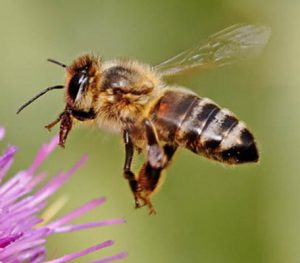 Nearly everyone has been stung by an insect at one time or another. It is an unpleasant experience that people hope not to repeat, but for most people the damage inflicted is only temporary pain. Only a very limited portion of the population (about two people out of 1,000) is allergic or hypersensitive to bee or wasp stings.
Nearly everyone has been stung by an insect at one time or another. It is an unpleasant experience that people hope not to repeat, but for most people the damage inflicted is only temporary pain. Only a very limited portion of the population (about two people out of 1,000) is allergic or hypersensitive to bee or wasp stings.
Stinging insects are limited to the order Hymenoptera, which includes wasps, bees, and ants. The stinger is a modified egg-laying apparatus, so only females can sting. Most hymenopterans live solitary lives and their behavior is more likely to be flight than fight. Social hymenopterans, including yellow jackets, honey bees, bumble bees, and fire ants, have individuals in the colony whose task it is to defend the nest. If the nest is disturbed, these individuals will defend it vigorously. In addition, foraging members of the colony will also sting if they are disturbed or injured as they go about their activities. Some, such as the yellow jacket, are much more liable to attack than others.
The Africanized honey bee is closely related to the European honey bee, which is used in agriculture for crop pollination and honey production. The two types of bees look the same and their behavior is similar in many respects. Neither is likely to sting when gathering nectar and pollen from flowers, but both will sting in defense if provoked.
An individual Africanized bee can sting only once and has the same venom as the European honey bee. However, Africanized honey bees are less predictable and more defensive than European honey bees. They are more likely to defend a greater area around their nest, and they respond faster and in greater numbers than the European honey bee.
Wasps
Only a few of the very large number of wasp species in California live a social life; these species are referred to as social wasps. Some social wasps are predators for most or all of the year and provide a great benefit by killing large numbers of plant-feeding insects and nuisance flies; others are exclusively scavengers. Wasps become a problem only when they threaten to sting humans. One of the most troublesome of the social wasps is the yellowjacket.
Identification
In western states there are two distinct types of social wasps: yellowjackets and paper wasps. Yellowjackets are by far the most troublesome group. Paper wasps are much less defensive and rarely sting humans. They tend to shy away from human activity except when their nests are located near doors, windows, or other high traffic areas.
Nests of both yellowjacket and paper wasps typically are begun in spring by a single queen who overwinters and becomes active when the weather warms. She emerges in late winter/early spring to feed and start a new nest. From spring to midsummer nests are in the growth phase, and the larvae require large amounts of protein. Workers forage mainly for protein at this time (usually in the form of other insects) and for some sugars. By late summer, however, the colonies grow more slowly or cease growth and require large amounts of sugar to maintain the queen and workers. So foraging wasps are particularly interested in sweet things at this time.
Normally, yellowjacket and paper wasp colonies only live one season. In very mild winters or in coastal California south of San Francisco, however, some yellowjacket colonies survive for several years and become quite large.
Yellowjackets
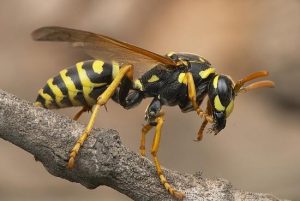 The term yellowjacket refers to a number of different species of wasps. Included in this group of ground-nesting species are the western yellowjacket, which is the most commonly encountered species and is sometimes called the "meat bee," and seven other species are common in rotted tree stumps at higher elevations (the German yellowjacket) is becoming more common in many urban areas of California, where it frequently nests in houses. These wasps tend to be medium sized and black with jagged bands of bright yellow (or white in the case of the aerial-nesting) on the abdomen, and have a very short, narrow waist (the area where the thorax attaches to the abdomen).
The term yellowjacket refers to a number of different species of wasps. Included in this group of ground-nesting species are the western yellowjacket, which is the most commonly encountered species and is sometimes called the "meat bee," and seven other species are common in rotted tree stumps at higher elevations (the German yellowjacket) is becoming more common in many urban areas of California, where it frequently nests in houses. These wasps tend to be medium sized and black with jagged bands of bright yellow (or white in the case of the aerial-nesting) on the abdomen, and have a very short, narrow waist (the area where the thorax attaches to the abdomen).
Paper Wasps
Paper wasps are large (1-inch long), slender wasps with long legs and a distinct, slender waist. Background colors vary, but most western species tend to be golden brown, or darker, with large patches of yellow or red. Preferring to live in or near orchards or vineyards, they hang their paper nests in protected areas, such as under eaves, in attics, or under tree branches or vines. Each nest hangs like an open umbrella from a pedicel (stalk) and has open cells that can be seen from beneath the nest. White, legless, grublike larvae sometimes can be seen from below. Paper wasp nests rarely exceed the size of an outstretched hand and populations vary between 15 to 200 individuals. Most species are relatively unaggressive, but they can be a problem when they nest over doorways or in other areas of human activity, such as fruit trees.
Mud Daubers
Mud daubers are black and yellow, thread-waisted, solitary wasps that build a hard mud nest, usually on ceilings and walls, attended by a single female wasp. They belong to the family Sphecidae and are not social wasps but may be confused with them. They do not defend their nests and rarely sting. During winter, you can safely remove the nests without spraying.
Fleas
 Cat fleas are the most common ectoparasite on domestic cats and dogs. Dog fleas look like cat fleas but are rare in California. Sticktight fleas, are commonly found on ground squirrels and poultry; the females firmly attach themselves along the ears and eyes of their host. They can become a problem with pets that roam. The ground squirrel flea is found on ground squirrels and is the vector of sylvatic plague in California. However, fleas on cats or dogs in California most likely are cat fleas.
Cat fleas are the most common ectoparasite on domestic cats and dogs. Dog fleas look like cat fleas but are rare in California. Sticktight fleas, are commonly found on ground squirrels and poultry; the females firmly attach themselves along the ears and eyes of their host. They can become a problem with pets that roam. The ground squirrel flea is found on ground squirrels and is the vector of sylvatic plague in California. However, fleas on cats or dogs in California most likely are cat fleas.
Identification
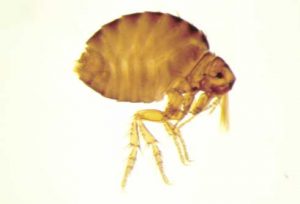 Adult fleas are no larger than 1/8 inch long, so it is difficult to see a number of the characteristics used to describe them. These reddish-brown, wingless insects are laterally compressed, so they look as if they are walking on edge. Cat fleas have both pronotal and genal combs. They have piercing-sucking mouthparts through which they obtain blood meals from their hosts.
Adult fleas are no larger than 1/8 inch long, so it is difficult to see a number of the characteristics used to describe them. These reddish-brown, wingless insects are laterally compressed, so they look as if they are walking on edge. Cat fleas have both pronotal and genal combs. They have piercing-sucking mouthparts through which they obtain blood meals from their hosts.
Flies
Of the thousands of species of flies, only a few are common pests in and around the home. Some of the more common nuisance flies are the house fly, the face fly, the stable fly, the little house fly, and several species of garbage fly. These pests breed in animal wastes and decaying organic material from which they can pick up bacteria and viruses that may cause human diseases. In addition, adult stable flies (sometimes called "biting flies") feed on mammalian blood and can give a painful bite.
Identification
The house fly is a cosmopolitan companion of humans and domestic animals. House flies are generally found in greatest numbers during the hotter summer months. House flies are less than 3⁄8 inch in length and have four dark stripes down the back of their thorax. House flies have sponging mouthparts and eat solid food by first liquefying it with their saliva. House flies can also regurgitate onto a solid food to assist with the liquefying process.
 All flies undergo complete complete metamorphosis with egg, larva, pupa, and adult stages in their development. The female fly deposits her eggs in animal waste or moist organic material where the larvae, or "maggots," complete their development, feeding on bacteria associated with their developmental site. When the maggots have completed their development and are ready to undergo the next step in their metamorphosis, they convert their last larval skin into a hardened shell within which the pupa develops. Within the puparium, the pupa transforms into an adult fly, which pops off the end of the puparium and emerges. Body fluids pump into the fly’s veins, causing the wings to unfold and expand and allowing them to dry and harden so that the adult can fly. The rate of fly development is dependent upon temperature, and under optimal summertime conditions flies may develop from egg to adult in as little as 7 days. Once the female fly has mated, she can lay several batches of eggs, typically containing over 100 eggs each.
All flies undergo complete complete metamorphosis with egg, larva, pupa, and adult stages in their development. The female fly deposits her eggs in animal waste or moist organic material where the larvae, or "maggots," complete their development, feeding on bacteria associated with their developmental site. When the maggots have completed their development and are ready to undergo the next step in their metamorphosis, they convert their last larval skin into a hardened shell within which the pupa develops. Within the puparium, the pupa transforms into an adult fly, which pops off the end of the puparium and emerges. Body fluids pump into the fly’s veins, causing the wings to unfold and expand and allowing them to dry and harden so that the adult can fly. The rate of fly development is dependent upon temperature, and under optimal summertime conditions flies may develop from egg to adult in as little as 7 days. Once the female fly has mated, she can lay several batches of eggs, typically containing over 100 eggs each.
While humans commonly find adult flies to be the most bothersome, the larval stage should be the prime target for control efforts. Elimination of larval habitat is the preferred method of pest fly suppression. By removing material in which the larvae develop, the life cycle of the fly can be broken, preventing subsequent production of adult flies. While chemical pesticides may be effective for suppressing adult fly populations in some situations, they are not a substitute for proper sanitation and aggressive elimination of nuisance fly developmental sites. Because flies can quickly develop resistance to insecticides, use them only as a last resort to obtain immediate control of adult flies.
Roaches
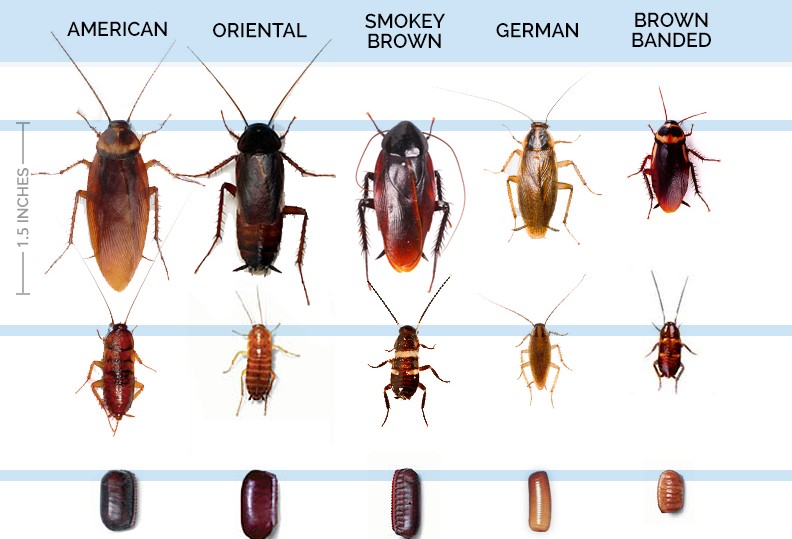 Cockroaches thrive in warm environments that provide food, water, and shelter. Roaches hide in cracks, crawl spaces, and other dark places during the day and come out at night to feed. Pesticide sprays alone will not control roaches and are not usually required. Baits provide better control. You must integrate several strategies to make your home a less roach-friendly environment. Thoroughness is essential for effective control.
Cockroaches thrive in warm environments that provide food, water, and shelter. Roaches hide in cracks, crawl spaces, and other dark places during the day and come out at night to feed. Pesticide sprays alone will not control roaches and are not usually required. Baits provide better control. You must integrate several strategies to make your home a less roach-friendly environment. Thoroughness is essential for effective control.
There are six species of cockroaches in California that can become pests: German cockroach, brown banded cockroach, oriental cockroach, smoky brown cockroach, American cockroach, and Turkestan cockroach. A seventh species, the field cockroach, is not really a pest. It is usually found outdoors, but sometimes comes indoors when it is hot or dry and is often mistaken for the German cockroach. Of these seven species, the one that has the greatest potential for becoming persistent and troublesome is the German cockroach, which prefers indoor locations. Oriental and American cockroaches occasionally pose problems in moist, humid areas.
Problems Associated with Cockroaches
Cockroaches contaminate food and eating utensils, destroy fabric and paper products, and impart stains and unpleasant odors to surfaces they contact.
People are repulsed when they find cockroaches in their homes and kitchens. Cockroaches (especially the American cockroach, which comes into contact with human excrement in sewers or with pet droppings) may transmit bacteria that cause food poisoning. German cockroaches are believed to be capable of transmitting disease-causing organisms such as Staphylococcus spp., Streptococcus spp., hepatitis virus, and coliform bacteria. They also have been implicated in the spread of typhoid and dysentery. Indoor infestations of cockroaches are an important source of allergens and risk for asthma among some populations. The levels of cockroaches and allergens are directly related to cockroach density, housing disrepair, and sanitary conditions.
Rodent
 The house mouse is one of the most troublesome and economically important rodents in the United States. House mice thrive under a variety of conditions; they are found in and around homes and commercial structures as well as in open fields and agricultural lands. House mice consume and contaminate food meant for humans, pets, livestock, or other animals. In addition, they cause considerable damage to structures and property, and they can transmit pathogens that cause diseases such as salmonellosis, a form of food poisoning.
The house mouse is one of the most troublesome and economically important rodents in the United States. House mice thrive under a variety of conditions; they are found in and around homes and commercial structures as well as in open fields and agricultural lands. House mice consume and contaminate food meant for humans, pets, livestock, or other animals. In addition, they cause considerable damage to structures and property, and they can transmit pathogens that cause diseases such as salmonellosis, a form of food poisoning.
Identification
House mice are small rodents with relatively large ears and small black eyes. They weigh about 1/2 ounce and usually are light brownish to gray in color. An adult is about 5 to 7 inches long, including the 3- to 4-inch tail.
 Droppings, fresh gnaw marks, and tracks indicate areas where mice are active. Mouse nests are made from fine shredded paper or other fibrous material, usually in sheltered locations. House mice have a characteristic musky odor that identifies their presence. Mice are active mostly at night, but they can be seen occasionally during daylight hours.
Droppings, fresh gnaw marks, and tracks indicate areas where mice are active. Mouse nests are made from fine shredded paper or other fibrous material, usually in sheltered locations. House mice have a characteristic musky odor that identifies their presence. Mice are active mostly at night, but they can be seen occasionally during daylight hours.
While the house mouse has not been found to be a carrier of Hantavirus, other mice have. Most notable are the deer mouse and the white-footed mouse, which sometimes invade cabins and outbuildings in California. The house mouse is distinguished from the deer mouse and the white-footed mouse by its overall gray-colored coat. The other two species have a white underside with a distinct line of demarcation between the dark coloration on top and the white underside. In addition, the tail on the house mouse has almost no fur on it, whereas the tails of the deer mouse and the white-footed mouse are moderately to well fur and are light underneath and dark on top.
 Norway rats sometimes called brown or sewer rats, are stocky burrowing rodents that are larger than roof rats. Their burrows are found along building foundations, beneath rubbish or woodpiles, and in moist areas in and around gardens and fields. Nests can be lined with shredded paper, cloth, or other fibrous material. When Norway rats invade buildings, they usually remain in the basement or ground floor. Norway rats live throughout the 48 contiguous United States. While generally found at lower elevations, this species can occur wherever people live.
Norway rats sometimes called brown or sewer rats, are stocky burrowing rodents that are larger than roof rats. Their burrows are found along building foundations, beneath rubbish or woodpiles, and in moist areas in and around gardens and fields. Nests can be lined with shredded paper, cloth, or other fibrous material. When Norway rats invade buildings, they usually remain in the basement or ground floor. Norway rats live throughout the 48 contiguous United States. While generally found at lower elevations, this species can occur wherever people live.
Roof rats, sometimes called black rats, are slightly smaller than Norway rats. Unlike Norway rats, their tails are longer than their heads and bodies combined. Roof rats are agile climbers and usually live and nest above ground in shrubs, trees, and dense vegetation such as ivy. In buildings, they are most often found in enclosed or elevated spaces such as attics, walls, false ceilings, and cabinets. The roof rat has a more limited geographical range than the Norway rat, preferring ocean-influenced, warmer climates. In areas where the roof rat occurs, the Norway rat might also be present.
While rats are much larger than the common house mouse, a young rat is occasionally confused with a mouse. In general, very young rats have large heads and feet in proportion to their bodies, whereas those of adult mice are proportionately much smaller. While both rats and mice gnaw on wood, rats leave much larger tooth marks than mice do.
Silver Fish
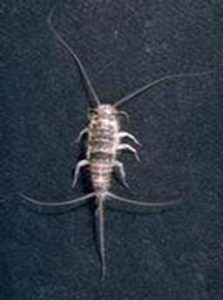 Silverfish and firebrats are nocturnal and hide during the day. If the object they are hiding beneath is moved, they will dart toward another secluded place. They come out at night to seek food and water. Both insects prefer dry food such as cereals, flour, pasta, and pet food; paper with glue or paste; sizing in paper including wallpaper; book bindings; and starch in clothing. Household dust and debris, dead insects, and certain fungi also are important sources of food. However, they can live for several months without nourishment.
Silverfish and firebrats are nocturnal and hide during the day. If the object they are hiding beneath is moved, they will dart toward another secluded place. They come out at night to seek food and water. Both insects prefer dry food such as cereals, flour, pasta, and pet food; paper with glue or paste; sizing in paper including wallpaper; book bindings; and starch in clothing. Household dust and debris, dead insects, and certain fungi also are important sources of food. However, they can live for several months without nourishment.
Large numbers of these insects can invade new homes from surrounding wild areas, especially as these areas dry out during the summer. They also can come in on lumber, wallboard, and similar products. Freshly laid concrete and green lumber supply humidity, while wallpaper paste provides food.
Identification
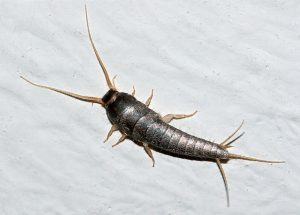 The common silverfish, is shiny, silver or pearl gray, and about 1/2 inch long, although it can grow as long as 3/4 inch. The common firebrat, is shiny, a mottled gray or brown, and about 1/2 inch long. Adults of both species are slender, wingless, soft-bodied insects with 2 long, slender antennae. Their bodies taper gradually from front to rear to 3 long, thin, tail like appendages.
The common silverfish, is shiny, silver or pearl gray, and about 1/2 inch long, although it can grow as long as 3/4 inch. The common firebrat, is shiny, a mottled gray or brown, and about 1/2 inch long. Adults of both species are slender, wingless, soft-bodied insects with 2 long, slender antennae. Their bodies taper gradually from front to rear to 3 long, thin, tail like appendages.
Although small nymphs (those that are less than 1/8 inch long) lack scales, both large nymphs and adults have them. If you see scales around or beneath damaged items, it is a good indication that these pests are the culprits. The scales are delicate, dust like, and slightly incandescent in the light, and they stick to most surfaces.
Spiders
Many people fear or dislike spiders but, for the most part, spiders are beneficial because of their role as predators of insects and other arthropods, and most cannot harm people. Spiders that might injure people—for example, black widows—generally spend most of their time hidden under furniture or boxes, or in woodpiles, corners, or crevices. The spiders commonly seen out in the open during the day are unlikely to bite people.
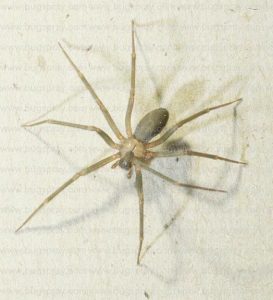 The Brown Recluse, notorious for poisonous bites, are not a common species in California: there are no populations of the brown recluse in the state and fewer than 20 verified specimens have been collected over several decades in California. Yet in California people frequently relate stories in which they or someone they know was supposedly bitten or they have had a physician diagnose them with a brown recluse spider bite. However, there are several other species of recluse spiders that can occur in southern areas of California and that can cause similar medical concerns.
The Brown Recluse, notorious for poisonous bites, are not a common species in California: there are no populations of the brown recluse in the state and fewer than 20 verified specimens have been collected over several decades in California. Yet in California people frequently relate stories in which they or someone they know was supposedly bitten or they have had a physician diagnose them with a brown recluse spider bite. However, there are several other species of recluse spiders that can occur in southern areas of California and that can cause similar medical concerns.
Identification
The most definitive physical feature of recluse spiders is their eyes: most spiders have eight eyes that typically are arranged in two rows of four, but recluse spiders have six equal-sized eyes arranged in three pairs, called dyads. There is a dyad at the front of the cephalothorax (the first main body part to which the legs attach) and another dyad on each side further back with a space separating the dyads from one another.
Some other spiders share each of these physical characteristics. However, to be identified as a recluse spider, it must have all five of these characteristics.
- Six eyes in dyads (pairs)
- Uniformly colored abdomen with fine hairs
- No spines on the legs
- Uniformly colored legs
- Body not more than 3/8” in length
Spider Identification
Spiders resemble insects and sometimes are confused with them, but they are arachnids, not insects. Spiders have eight legs and two body parts—a head region and an abdomen. They lack wings and antennae. Although spiders often are found on plants, they eat mainly insects, other spiders, and related arthropods, not plants. Most spiders have toxic venom, which they use to kill their prey. However, only those spiders whose venom typically causes a serious reaction in humans are called “poisonous” spiders.
Common Spider Families in North America.
Funnel weavers or grass spiders
 Sit-and-wait predators feed during the day and night on the ground in most types of vegetation, including low-growing plants and trees. Spin funnel-shaped webs, often with several-inch-wide, flat extension covering plants or soil. The spider waits in the hole of its web. When it detects vibrations from an insect that flew or walked into the web, the spider runs out, captures and bites the prey, then carries it back into the funnel to be eaten. Webs on low vegetation become conspicuous in morning light after collecting dew. Funnel weavers have six or eight eyes, all about the same size, arranged in two rows. About 300 species in North America.
Sit-and-wait predators feed during the day and night on the ground in most types of vegetation, including low-growing plants and trees. Spin funnel-shaped webs, often with several-inch-wide, flat extension covering plants or soil. The spider waits in the hole of its web. When it detects vibrations from an insect that flew or walked into the web, the spider runs out, captures and bites the prey, then carries it back into the funnel to be eaten. Webs on low vegetation become conspicuous in morning light after collecting dew. Funnel weavers have six or eight eyes, all about the same size, arranged in two rows. About 300 species in North America.
Orb weavers or garden spiders
 Feed on insects that fly, fall, or are blown into web. Elaborate silken webs are spun in concentric circles. Spiderlings often make symmetrical webs; mature spiders may spin a more specialized design that is helpful in identifying certain species. The spider rests at the center of its web or hides in a shelter near the edge, waiting for prey to become entangled. Orb weavers generally have poor vision and rely on web vibrations to locate and identify prey. About 200 species in North America.
Feed on insects that fly, fall, or are blown into web. Elaborate silken webs are spun in concentric circles. Spiderlings often make symmetrical webs; mature spiders may spin a more specialized design that is helpful in identifying certain species. The spider rests at the center of its web or hides in a shelter near the edge, waiting for prey to become entangled. Orb weavers generally have poor vision and rely on web vibrations to locate and identify prey. About 200 species in North America.
Sac spiders or two-clawed hunting spiders
 Stalk and capture prey that is walking or resting on surfaces. They spin silken tubes or sacs under bark, among leaves, and in low plants or on the ground, where they hide during the day or retreat after hunting. Commonly are nocturnal, medium-sized, pale spiders with few markings. About 200 species in North America.
Stalk and capture prey that is walking or resting on surfaces. They spin silken tubes or sacs under bark, among leaves, and in low plants or on the ground, where they hide during the day or retreat after hunting. Commonly are nocturnal, medium-sized, pale spiders with few markings. About 200 species in North America.
Dwarf spiders
 Prey on insects that fall, walk, or land in their web. Diurnal (day active) spiders occurring in the plant canopy and among litter on the ground. They produce sheetlike webs on the surface of plants or soil and are common in some field and vegetable crops. Most are relatively small. Several hundred species in North America.
Prey on insects that fall, walk, or land in their web. Diurnal (day active) spiders occurring in the plant canopy and among litter on the ground. They produce sheetlike webs on the surface of plants or soil and are common in some field and vegetable crops. Most are relatively small. Several hundred species in North America.
Wolf spiders
 Prey on insects that are walking or resting on the ground. Actively hunt in the open during the day and night, often observed on the ground in litter and on low vegetation. Can occur in burrows and under debris on soil. Instead of spinning webs to catch prey, make a small, thick web where they rest. Have a distinctive pattern of eyes: four small eyes in front in a straight row, one middle pair of larger eyes, and one rear pair of widely spaced eyes on top of the head. They have long hairy legs. They are usually black and white or strongly contrasting light and dark, which can make them difficult to discern unless they are moving. About 200 species in North America.
Prey on insects that are walking or resting on the ground. Actively hunt in the open during the day and night, often observed on the ground in litter and on low vegetation. Can occur in burrows and under debris on soil. Instead of spinning webs to catch prey, make a small, thick web where they rest. Have a distinctive pattern of eyes: four small eyes in front in a straight row, one middle pair of larger eyes, and one rear pair of widely spaced eyes on top of the head. They have long hairy legs. They are usually black and white or strongly contrasting light and dark, which can make them difficult to discern unless they are moving. About 200 species in North America.
Lynx spiders
 Stalk and capture resting or walking insects. Active hunters with good vision. Most have spiny legs and a brightly colored body that tapers sharply toward the rear. They have four pairs of eyes grouped in a hexagon. About 2 dozen known species in North America.
Stalk and capture resting or walking insects. Active hunters with good vision. Most have spiny legs and a brightly colored body that tapers sharply toward the rear. They have four pairs of eyes grouped in a hexagon. About 2 dozen known species in North America.
Jumping spiders
 Day-active hunters in plants or on the ground. They make no web; instead they stalk and pounce on prey by jumping distances many times their body length. Jumping spiders have a distinctive pattern of eyes in three rows: the first row of four eyes, with large and distinctive middle eyes; a second row of two very small to minute eyes; and a third row of two medium sized eyes. They usually have an iridescent, metallic-colored abdomen and black carapace. About 300 species in North America.
Day-active hunters in plants or on the ground. They make no web; instead they stalk and pounce on prey by jumping distances many times their body length. Jumping spiders have a distinctive pattern of eyes in three rows: the first row of four eyes, with large and distinctive middle eyes; a second row of two very small to minute eyes; and a third row of two medium sized eyes. They usually have an iridescent, metallic-colored abdomen and black carapace. About 300 species in North America.
Cobweb weaver, or combfooted spiders
 Feed on insects that walk or fly into their webs. Almost always found hanging upside down by their claws in irregularly spun, sticky webs, waiting for prey. The spider is usually concealed in a corner of the web, in a silken tent, or behind debris. This group includes the black widow spider, which produces relatively thick silk that feels rough and sticky. They generally have a soft, round, bulbous abdomen and slender legs without spines. Over 200 species in North America.
Feed on insects that walk or fly into their webs. Almost always found hanging upside down by their claws in irregularly spun, sticky webs, waiting for prey. The spider is usually concealed in a corner of the web, in a silken tent, or behind debris. This group includes the black widow spider, which produces relatively thick silk that feels rough and sticky. They generally have a soft, round, bulbous abdomen and slender legs without spines. Over 200 species in North America.
Crab spiders or flower spiders
 Stalk and capture insects walking or resting on surfaces. Diurnal hunters that do not spin webs. Front two pairs of legs are enlarged and extend beyond the side of their flattened body, making them look like tiny crabs. Their small eyes occur in two slightly curved rows, with the top row often much wider than the lower row. Over 200 species in North America.
Stalk and capture insects walking or resting on surfaces. Diurnal hunters that do not spin webs. Front two pairs of legs are enlarged and extend beyond the side of their flattened body, making them look like tiny crabs. Their small eyes occur in two slightly curved rows, with the top row often much wider than the lower row. Over 200 species in North America.
Spider Bites
Unlike mosquitoes, spiders do not seek people in order to bite them. Generally, a spider doesn’t try to bite a person unless it has been squeezed, lain on, or similarly provoked to defend itself. Moreover, the jaws of most spiders are so small that the fangs cannot penetrate the skin of an adult person. Sometimes when a spider is disturbed in its web, it may bite instinctively because it mistakenly senses that an insect has been caught.
The severity of a spider bite depends on factors such as the kind of spider, the amount of venom injected, and the age and health of the person bitten. A spider bite might cause no reaction at all, or it might result in varying amounts of itching, redness, stiffness, swelling, and pain—at worst, usually no more severe than a bee sting. Typically the symptoms persist from a few minutes to a few hours. Like reactions to bee stings, however, people vary in their responses to spider bites, so if the bite of any spider causes an unusual or severe reaction, such as increasing pain or extreme swelling, contact a physician, hospital, or poison control center (in California, the number is 1-800-222-1212).
Sometimes a person may not be aware of having been bitten until pain and other symptoms begin to develop. Other species of arthropods whose bites or stings may be mistaken for that of a spider include ticks, fleas, bees, wasps, bedbugs, mosquitoes, the conenose (kissing) bug, deer flies, horse flies, and water bugs.
For first aid treatment of a spider bite, wash the bite, apply an antiseptic to prevent infection, and use ice or ice water to reduce swelling and discomfort. Bites or stings from a variety of arthropods can result in an itching wound. Rather than scratching, if necessary, try to relieve the itch with medication. Scratching can break the skin and introduce bacterial infection, which you or even a physician may mistake for an arachnid bite. If you receive a bite that causes an unusual or severe reaction, contact a physician. If you catch the critter in the act, save it for identification, preserve it (or whatever parts of it remain), and take it to your county UC Cooperative Extension office. If no one there can identify it, ask that it be forwarded to a qualified arachnologist.
Black Widow Spider
The black widow spider, is the most common harmful spider in California. Venom from its bite can cause reactions ranging from mild to painful and serious, but death is very unlikely and many symptoms can be alleviated if medical treatment is obtained. Anyone bitten by this spider should remain calm and promptly seek medical advice; it is helpful if the offending spider can be caught and saved for identification.
The typical adult female black widow has a shiny black body, slender black legs, and a red or orange mark in the shape of an hourglass on the underside of the large, round abdomen. The body, excluding legs, is 5/16 to 5/8 inch long. Only the larger immature female and adult female spiders are able to bite through a person’s skin and inject enough venom to cause a painful reaction.
The adult male black widow is one-half to two-thirds the length of the female, has a small abdomen, and is seldom noticed. The male black widow does possess venom, but its fangs are too small to break human skin. The top side of its abdomen is olive-greenish gray with a pattern of cream-colored areas and one light-colored band going lengthwise down the middle. The hourglass mark on the underside of the abdomen typically is yellow or yellow-orange and broad waisted. The legs are banded with alternating light and dark areas. Contrary to popular belief, the female black widow rarely eats the male after mating but may do so if hungry. Like males, young female black widow spiders are patterned on the top side. In the early stages they greatly resemble males but gradually acquire the typical female coloration with each shedding of the skin. In intermediate stages they have tan or cream-colored, olive-gray, and orange markings on the top side of the abdomen, a yellowish orange hourglass mark on the underside, and banded legs.
Webs and Egg Sacs. The web of the black widow is an irregular, tough-stranded, sticky cobweb mesh in which the spider hangs with its underside up. During the day it often hides under an object at the edge of the web or stays in a silken retreat in the center. The black widow may rush out of its hiding place when the web is disturbed, especially if egg sacs are present. The egg sacs are mostly spherical, about 1/2 inch long and 5/8 inch in diameter, creamy yellow to light tan in color, opaque, and tough and paperlike on the surface. A female may produce several egg sacs. Tiny, young black widows, which are nearly white in color, disperse to new locations by ballooning and infest new areas.
Where the Spiders Live. Black widow spiders occur in most parts of California. They and their associated webs usually are found in dark, dry, sheltered, relatively undisturbed places such as among piles of wood, rubbish, or stones; in culverts, hollow stumps, and old animal burrows; in garages, sheds, barns, crawl spaces, utility meter boxes, and outhouses; and sometimes among plants. People are most likely to be bitten when they disturb the spider while they are cleaning out or picking up items in such places. A sensible precaution is to always wear gloves and a long-sleeved shirt when working in areas that have been undisturbed for a time and where there are good hiding places for spiders.
Effects of the Bite. The symptoms of a black widow bite are largely internal; little more than local redness and swelling may develop at the bite site. The internal effects may range from mild to severe. Pain tends to spread from the bite to other parts of the body and muscular spasms may develop. In severe cases the abdominal muscles may become quite rigid. Other effects can include profuse sweating, fever, increased blood pressure, difficulty breathing and speaking, restlessness, and nausea. Typically, the pain and other symptoms reach a maximum within a day of the bite, then gradually subside over the next 2 to 3 days. Most people who are bitten spend a few hours under observation by a physician but do not develop symptoms severe enough to require treatment. Small children, the elderly, and persons with health problems are likely to suffer some of the more severe consequences of the bite. Black widow bites are fairly common in California.




